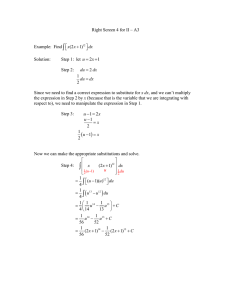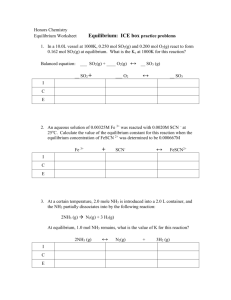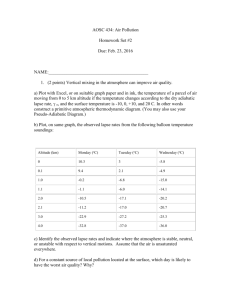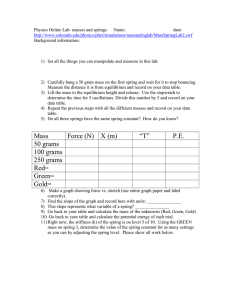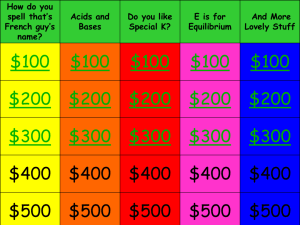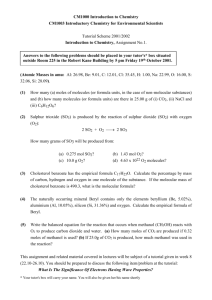MT 2 practice
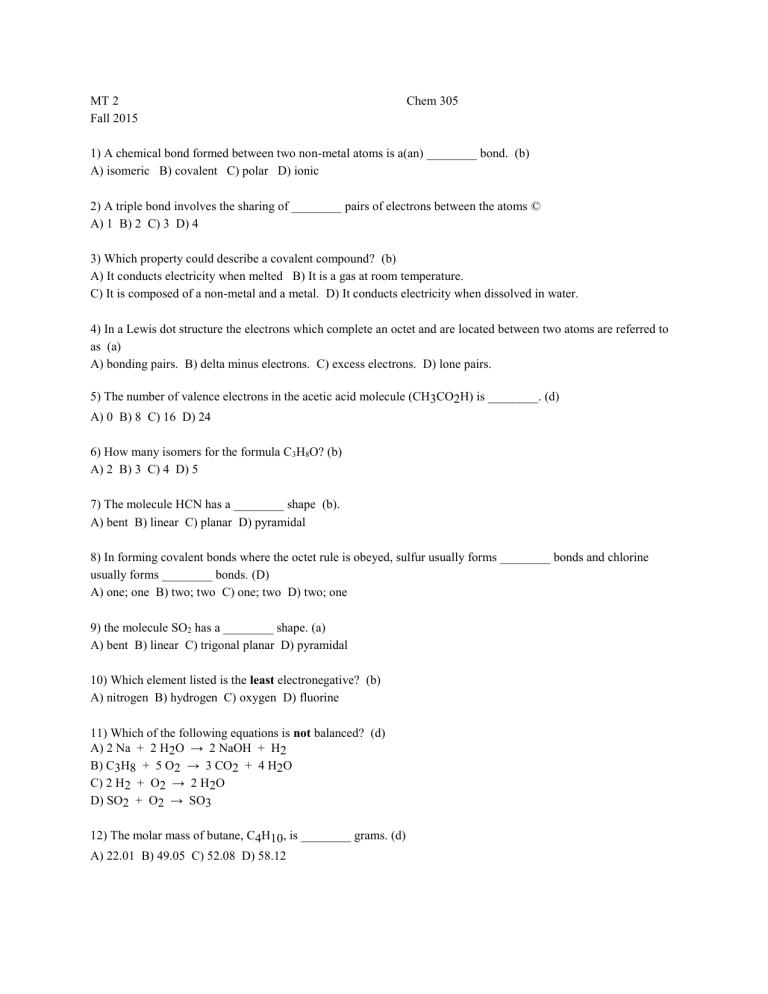
MT 2
Fall 2015
Chem 305
1) A chemical bond formed between two non-metal atoms is a(an) ________ bond. (b)
A) isomeric B) covalent C) polar D) ionic
2) A triple bond involves the sharing of ________ pairs of electrons between the atoms ©
A) 1 B) 2 C) 3 D) 4
3) Which property could describe a covalent compound? (b)
A) It conducts electricity when melted B) It is a gas at room temperature.
C) It is composed of a non-metal and a metal. D) It conducts electricity when dissolved in water.
4) In a Lewis dot structure the electrons which complete an octet and are located between two atoms are referred to as (a)
A) bonding pairs. B) delta minus electrons. C) excess electrons. D) lone pairs.
5) The number of valence electrons in the acetic acid molecule (CH3CO2H) is ________. (d)
A) 0 B) 8 C) 16 D) 24
6) How many isomers for the formula C
3
H
8
O? (b)
A) 2 B) 3 C) 4 D) 5
7) The molecule HCN has a ________ shape (b).
A) bent B) linear C) planar D) pyramidal
8) In forming covalent bonds where the octet rule is obeyed, sulfur usually forms ________ bonds and chlorine usually forms ________ bonds. (D)
A) one; one B) two; two C) one; two D) two; one
9) the molecule SO
2
has a ________ shape. (a)
A) bent B) linear C) trigonal planar D) pyramidal
10) Which element listed is the least electronegative? (b)
A) nitrogen B) hydrogen C) oxygen D) fluorine
11) Which of the following equations is not balanced? (d)
A) 2 Na + 2 H2O → 2 NaOH + H2
B) C3H8 + 5 O2 → 3 CO2 + 4 H2O
C) 2 H2 + O2 → 2 H2O
D) SO2 + O2 → SO3
12) The molar mass of butane, C4H10, is ________ grams. (d)
A) 22.01 B) 49.05 C) 52.08 D) 58.12
13) The molecular weight of PCl3 is ________ grams. (
A) 66.42 B) 136.00 C) 137.33 D) 139.00
14) When the reaction shown is correctly balanced, the coefficients are: ( b)
C6H14 (l) + O2 (g) → CO2 (g) + H2O (g)
A) 1, 6, 6, 7 B) 2, 19, 12, 14 C) 1, 3.5, 6, 7 D) 1, 9.5, 6, 7
15) A thimble of water contains 4.0 × 1021 molecules. The number of moles of H2O is: (b)
A) 2.4 × 1045 B) 6.6 × 10-3 C) 6.6 × 10-23 D) 2.4 × 1023
16) How many molecules are present in 1.36 g of AgNO3? (b)
A) 3.84 × 10-22 B) 4.82 × 1021 C) 1.36 × 1023 D) 7.52 × 1025
17) How many grams of C will be consumed when 5.00 grams of Na2SO4 react according to the balanced reaction shown? (
Na2SO4 + 2 C → Na2S + 2 CO2
A) 0.038 g B) 0.211 g C) 0.844 g D) 1.69 g
18) How many grams of fluorine are required to produce 20.0 grams of FeF3 from the reaction shown?
2 Fe + 3F2 → 2 FeF3
A) 4.49 g B) 5.05 g C) 6.74 g D) 10.1 g
19) How much Ca(NO3)2 should be weighed out to have 0.650 mol?
A) 66.4 g B) 97.6 g C) 107 g D) 133 g
20) The reaction 2 C3H8(g) + 5O2 (aq) → 3 CO3 (aq) + 4H2O (s) is an example of a(an) ________ reaction. (d)
A) acid-base B) oxidation-reduction C) precipitation D) combustion
21) A process or reaction which takes in heat from the surroundings is said to be (b)
A) conservative. B) endothermic. C) exothermic. D) isothermal.
22) Entropy can be defined as (a)
A) the amount of energy required to rearrange chemical bonds.
B) the amount of disorder in a system.
C) the number of chemical bonds which are changed during a reaction.
D) the state of equilibrium in a system.
23) A reaction which is unfavorable with respect to entropy, but favorable with respect to enthalpy (c)
A) could occur at any temperature.
B) could not occur regardless of temperature.
C) could occur at low temperatures but not at higher temperatures.
D) could occur at high temperatures but not at lower temperatures.
24) Which factors would decrease the rate of a reaction? (a)
I. Lowering the temperature
II. Increasing the concentration of reactants
III. Adding a catalyst
A) I only B) II only C) III only D) II and III
25) Which of the following conditions characterizes a system in a state of chemical equilibrium? (c)
A) Concentrations of reactants and products are equal.
B) Rate of forward reaction has dropped to zero.
C) Reactants are being consumed at the same rate they are being produced.
D) Reactant molecules no longer react with each other.
26) Consider the reaction: (D)
A + 2 B 2 C + D
The equilibrium expression for this reaction is:
A) B) C) D)
27) Calculate the equilibrium constant for the reaction below if a tank was found to contain 0.106 M O2, 0.00652 M
SO3 and 0.00129 M SO2.
2 SO3 (g) 2 SO2 (g) + O2 (g)
A) 6.78 × 10-2 B) 1.34 × 10-2 C) 4.15 × 10-3 D) 4.35 × 10-2
28) The position of the equilibrium for a system where K = 4.6 × 10-15 can be described as being favored to
________; the concentration of products is relatively ________. (d)
A) the right; large B) the right; small C) the left; large D) the left; small
29) 2 SO2 (g) + O2 (g) 2 SO3 (g) + heat K = 4.8 × 1027
Which statement about this system is not true? (d)
A) At equilibrium SO3 is the predominant substance.
B) Heating the system will cause breakdown of SO3.
C) Adding SO2 will cause an increase in the amount of SO3.
D) Removing O2 will cause an increase in the amount of SO3.
30) Which change to this reaction system would cause the equilibrium to shift to the right? (d)
N2 (g) + 3 H2 (g) 2 NH3 (g) + heat
A) addition of a catalyst B) addition of NH3 (g) C) removal of H2 (g) D) lowering the temperature
